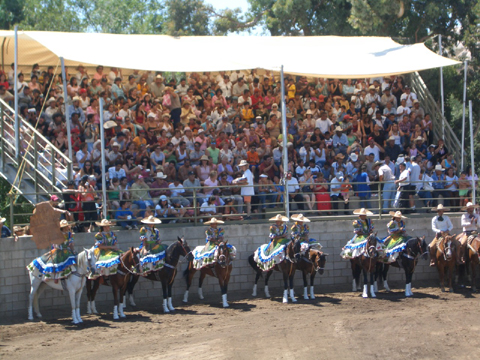
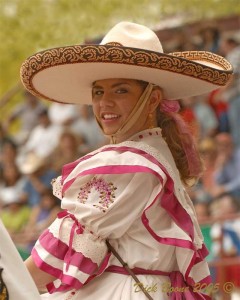 The charreada is a type of rodeo developed in Mexico based on the working practices of charros (cowboys). There is a long historical tradition but in recent times there has been a lot of criticism of some of the events because they seem especially harmful to the livestock. The skills of the riders are really outstanding and I hope a way is found to keep the tradition alive while protecting the cows and horses involved.
The charreada is a type of rodeo developed in Mexico based on the working practices of charros (cowboys). There is a long historical tradition but in recent times there has been a lot of criticism of some of the events because they seem especially harmful to the livestock. The skills of the riders are really outstanding and I hope a way is found to keep the tradition alive while protecting the cows and horses involved.
From Wikipedia:
“The event was developed after the Mexican Revolution when charro traditions were slowly disappearing. A charreada consists of nine events for men and one for women. In the 1970s, charreada was established in the United States of America, but has met with criticism; some events have been banned in the US as a result.
“Following the breakup of the haciendas by the Mexican Revolution, the charros saw their traditions slipping away. They met in 1921 and formed the Asociación Nacional de Charros to keep the charrería tradition alive. The advent of the Mexican cinema brought greater popularity, especially musicals which combined rancheras with the charro image, akin to the Western and “singing cowboy” genres in the United States.
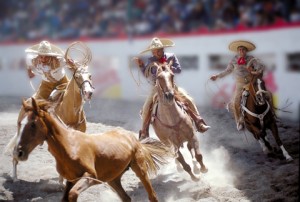 “Mexican Americans in the United States also held various charreadas during the same period, but in the 1970s, the Federación Mexicana de Charrería began assisting them in establishing official charreadas north of the border. They are now quite common. The US champion team now competes in the national competition of Mexico. Forefooting and Steer Tailing of the charreada have met with criticism in the US and have been banned.
“Mexican Americans in the United States also held various charreadas during the same period, but in the 1970s, the Federación Mexicana de Charrería began assisting them in establishing official charreadas north of the border. They are now quite common. The US champion team now competes in the national competition of Mexico. Forefooting and Steer Tailing of the charreada have met with criticism in the US and have been banned.
“Charras in parade wearing the traditional Adelita. The participants in charreada wear traditional charro clothing. An opening ceremony features organizations and participants parading into the arena on horseback, usually accompanied by a mariachi band playing Zacatecas March. The charreada itself consists of nine scoring events staged in a particular order for men. Unlike rodeos, most charreadas do not award money to the winners as charreadas are considered an amateur, rather than professional sport. Prizes may take the form of trophies. Unlike American rodeo, events are not timed but judged and scored based on finesse and grace. Charreada historically enjoys greater prestige in Mexico than in the United States.
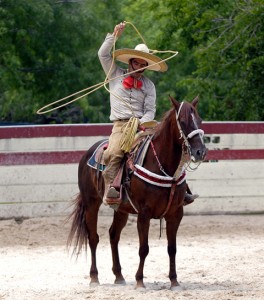 “Until recently, the charreada was confined to men but a women’s precision equestrian event called the escaramuza is now the tenth and final event in a charreada. The event involves women’s teams dressed in a style reminiscent of the nineteenth century participating in precisely choreographed patterns for horses.
“Until recently, the charreada was confined to men but a women’s precision equestrian event called the escaramuza is now the tenth and final event in a charreada. The event involves women’s teams dressed in a style reminiscent of the nineteenth century participating in precisely choreographed patterns for horses.
A charreada is held within a marked-off area of an arena consisting of a lane 12 meters (13 yards) wide by 60 meters (66 yards) long leading into a circle 40 meters (44 yards) in diameter. The participants must wear traditional charro clothing while performing. Preceding the events is an opening ceremony in which the organizations and participants parade into the arena on horseback, usually accompanied by a mariachi band playing Zacatecas March.
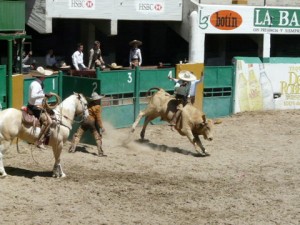 “The charreada itself consists of a number of scoring events staged in a particular order—nine for the men and one for the women. Two or more teams, called asociaciones, compete against each other. Teams can compete to become state, regional, and national champions. The competitors are judged by both style and execution. Unlike rodeos, most charreadas do not award money to the winners as charreadas are considered an amateur sport, not professional. Under Mexican laws it would be illegal to receive a monetary reward for participating in a charreada. At times there are such prizes as saddles or horse trailers.
“The charreada itself consists of a number of scoring events staged in a particular order—nine for the men and one for the women. Two or more teams, called asociaciones, compete against each other. Teams can compete to become state, regional, and national champions. The competitors are judged by both style and execution. Unlike rodeos, most charreadas do not award money to the winners as charreadas are considered an amateur sport, not professional. Under Mexican laws it would be illegal to receive a monetary reward for participating in a charreada. At times there are such prizes as saddles or horse trailers.
1. Cala de Caballo (Reining); The charro puts his horse though various commands to demonstrate his ability and the horse’s training.
2. Piales en Lienzo (Heeling); a horseman must throw a lariat, let a wild mare run through the loop catching it by the hind legs. Three opportunities are given. Points are awarded for distance needed to stop the mare. This is done in the rectangular portion of the arena;
3. Colas en el Lienzo, or Coleadero (Steer Tailing) similar to bull dogging except that the rider does not dismount; the charro rides alongside the left side of the bull, wraps its tail around his right leg, and tries to bring the bull down in a roll as he rides past it. Points are given for technique, time, and roll of the bull.
4. Jineteo de Toro (Bull riding) similar to the rodeo event. Bulls are smaller, between 990 and 1320 pounds, and are ridden until they stop bucking. Two hands can be used on the bullrope. Points are given for technique. The charro cannot fall off, he must dismount and land upright. After the charro dismounts the bull he must remove the bullrope and bellrope so the Terna en el Ruedo can follow.
5. Terna en el Ruedo (Team Roping); a team roping event in which three charros attempt to rope a bull – one by its neck, one by its hind legs, and the last then ties its feet together. They have a maximum of 6 minutes. Points are awarded for rope tricks and time.
6. Jineteo de Yegua (Bareback on a wild mare); similar to Bareback bronc riding. Yegua means mare. A wild mare is riden with a bullrope. Two hands are used and the legs are held horizontally to the ground.
7. Manganas a Pie (Forefooting) a charro on foot (pie) has three opportunities to rope a wild mare by its front legs and cause it to fall and roll once. The wild mare is chased around the ring by three mounted charros or hazers. Points are awarded for time and rope tricks as long as the horse is roped and brought down. Extra points are given for the tirón del ahorcado (hanged pull) in which the rope is around the charro’s neck, like a noose, and he uses his body to cause the mare to fall and roll. Points for all three attempts are cumulative. Eight minutes are given.
8. Manganas a Caballo or (Forefooting on Horseback); a charro on horseback has three opportunities to rope a wild mare by its front legs and cause it to fall and roll once. The wild mare is chased around the ring by three mounted charros. Points are awarded for time and rope tricks as long as the horse is roped and brought down. Points for all three attempts are cumulative. Eight minutes are given.
9. El Paso de la Muerte (The pass of death) a charro riding bareback, with reins, attempts to leap from his own horse to the bare back of a wild horse without reins and ride it until it stops bucking. The most dangerous part of this is if the charro performing the pass falls under three other mounted charros that are chasing the wild mare around the arena ring. This is done backwards at times for show.
10. Escaramuza (English: “skirmish”) is an event for teams of 8-12 women who perform precision equestrian displays riding sidesaddle and garbed in Adelita dress. It is usually held between the Coleadero and the Jineteo de Toro. It became the tenth official event of the charreada in 1992.”
If you have problems seeing the video below click HERE.
youtube::2zeG7XxlM-s::
